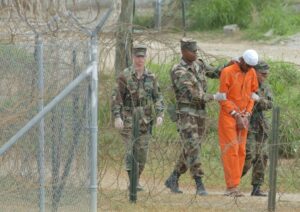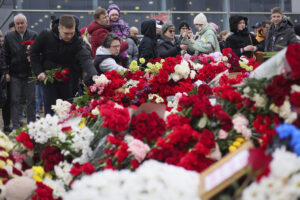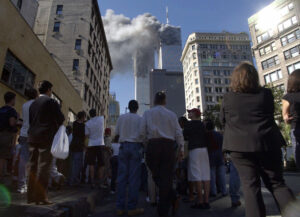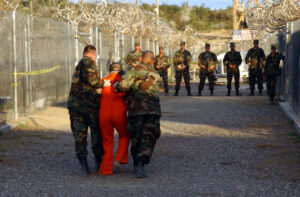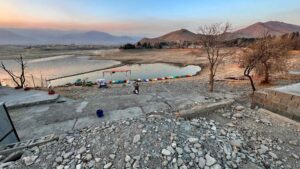The American Empire: Murder Inc.
Investigative journalist Allan Nairn knows firsthand how the U.S. uses mass killing as a routine tool of foreign policy. The horrifying tactics of Islamic State, he says, are an imitation of what we have been doing and what we have been teaching our international proxies for generations. Update: Video added.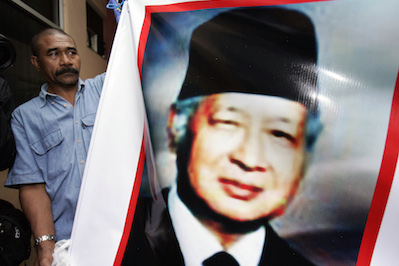
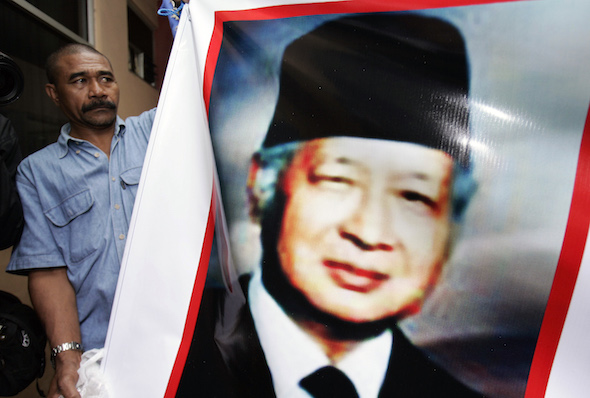
As Indonesia’s former President Suharto lay ill in 2008, a supporter displayed a portrait of him outside the Jakarta hospital where the military dictator died two weeks later. It was in Suharto’s brutal three-decade reign that Indonesia invaded East Timor, where investigative journalist Allan Nairn covered atrocities the general’s troops committed. (Vincent Thian / AP)
Terror, intimidation and violence are the glue that holds empire together. Aerial bombardment, drone and missile attacks, artillery and mortar strikes, targeted assassinations, massacres, the detention of tens of thousands, death squad killings, torture, wholesale surveillance, extraordinary renditions, curfews, propaganda, a loss of civil liberties and pliant political puppets are the grist of our wars and proxy wars.
Countries we seek to dominate, from Indonesia and Guatemala to Iraq and Afghanistan, are intimately familiar with these brutal mechanisms of control. But the reality of empire rarely reaches the American public. The few atrocities that come to light are dismissed as isolated aberrations. The public is assured what has been uncovered will be investigated and will not take place again. The goals of empire, we are told by a subservient media and our ruling elites, are virtuous and noble. And the vast killing machine grinds forward, feeding, as it has always done, the swollen bank accounts of defense contractors and corporations that exploit natural resources and cheap labor around the globe.
There are very few journalists who have covered empire with more courage, tenacity and integrity than Allan Nairn. For more than three decades, he has reported from Central America, East Timor, Palestine, South Africa, Haiti and Indonesia — where Indonesian soldiers fractured his skull and arrested him. His reporting on the Indonesian government massacres in East Timor saw him branded a “threat to national security” and officially banned from occupied East Timor. Nairn returned clandestinely to East Timor on numerous occasions. His dogged reporting of torture and killing of civilians by the Indonesian military contributed to the U.S. Congress suspending military aid to Jakarta in 1993. He exposed U.S. complicity with death squads and paramilitary organizations carrying out murderous rampages in El Salvador, Guatemala and Haiti. During the 2014 presidential elections in Indonesia, where he spends much of his time, Nairn was threatened with arrest for exposing presidential candidate Prabowo Subianto’s role in atrocities. Nairn’s reporting on army massacres was an important component in the trial of former Guatemalan President Efrain Ríos Montt. Gen. Montt ordered the killing of over 1,700 people in the Ixil region of the country in the early 1980s and was convicted in 2013 of genocide and crimes against humanity. He was sentenced to 80 years in prison. The conviction was later overturned.
Nairn, whom I spoke with in New York, reaches back to the genocide carried out against Native Americans, the institution of slavery and the murder of hundreds of workers and labor union organizers in the 19th and early 20th century to explain the roots of American imperial violence. He noted that, although wholesale massacres have become taboo on American soil in recent generations, the FBI was carrying out selective assassinations of black radicals, including Fred Hampton, in the 1960s. And police show little constraint in gunning down unarmed people of color in poor communities.
But overseas there are no restrictions. The indiscriminate slaughter of real or imagined opponents is considered a prerogative of imperial power. Violence is the primary language we use to speak to the rest of the world. Equivalents of Wounded Knee and My Lai take place beyond our borders with an unacknowledged frequency.
“To this day,” Nairn said, “it is politically permissible for U.S. forces to carry out or sponsor assassinations of civilians—students, journalists, religious leaders, peasant organizers, whomever. In fact, in U.S. politics, if presidents are reluctant, or seem reluctant to do this, they get castigated. They get called a wimp. George Bush Sr. came under vicious attack when he attempted through covert means to mount a coup in Panama against [Manuel] Noriega and it failed. And there was a cover [of Newsweek, with the headline ‘Fighting the “Wimp Factor” ‘] where they were attacking Bush Sr. for not being strong enough.”
“I think it was within a week after that he invaded Panama formally, an invasion that included the burning of the neighborhood called El Chorrillo, where hundreds were killed, a poor neighborhood. The New York Times then ran a front-page analysis by R.W. Apple which said that Bush Sr. had completed his presidential initiation rite by demonstrating his willingness to shed blood,” Nairn went on. “Not his own blood, but the blood of foreigners, including of foreign civilians.”“It’s basically a refusal on the part of American society to enforce the murder laws when the killings are done by presidents or generals, and where the victims are foreigners,” he said. “Now, all big powers do this. But in the recent period, because the U.S. has been the dominant power, the U.S. has the biggest death toll. If you added all the operations up it would go into the several millions. Just to list the ones that I’ve personally seen and tried to expose and fight against: Guatemala, El Salvador, Nicaragua, Honduras, Haiti, South Africa, Palestine, East Timor, Indonesia, southern Thailand. I’m sure I’m leaving out a few. The U.S. has used the Pentagon, the CIA, occasionally the State Department to set up or back local forces, help them gather intelligence on dissidents, and help them provide the means to carry out systematic assassinations.”
Assassinations and torture are often accompanied in these wars and proxy wars by massacres by government troops that routinely “wipe out whole villages,” Nairn said,
“The Guatemalan military did that, especially during the early ’80s when the Reagan administration was backing them enthusiastically under the time of the dictator Gen. Rios Montt,” Nairn said. “They would go into villages in the Mayan highlands in the northwest. … I was there, I spoke to the soldiers as they were doing it, I spoke to survivors … [and] they would decapitate people. They would crucify people. They would use the tactics that ISIS today puts on video that are now shocking the world.”
“The powers have always been willing to use these tactics,” he said. “And for centuries they were proud of it. All you have to do is look at the holy texts of the major religions—the Bible, the Quran, the Torah. They’re full of one massacre after another. People forget. The story of David and Goliath is put forward as a great story. At the end of that story David decapitates Goliath. He parades around holding up his head. For years and years the powers were proud of these tactics. They advertised it.”
“As recently as the presidency of Teddy Roosevelt, U.S. presidents were still boasting about it,” Nairn said. “Go back and read [Roosevelt’s] writings. He’s repeatedly … talking about the necessity to shed blood, the necessity to kill. Otherwise a person could not be healthy, otherwise a polity could not be healthy. This was Teddy Roosevelt. You can’t do that in today’s U.S. You can’t do that really in any major country today. The only partial exception to that at the level of rhetoric is Israel. Israeli generals and politicians still talk openly about the need to shed Palestinian blood. But they’re really the only ones. Everywhere else—Europe, Russia, China, the U.S.—they have to hide their [activities].”
I first met Nairn in 1984 while I was covering the war in El Salvador. In that year he published an explosive investigative piece in The Progressive magazine titled “Behind the Death Squads.” The article detailed U.S. backing, training and arming of the death squads in El Salvador that were murdering, and often torturing and mutilating, hundreds of people a month. His article led to an investigation by the Senate Intelligence Committee.
U.S. commanders in Iraq, attempting to quell the Sunni insurgency in 2004, reached back to the terror tactics used in El Salvador. They formulated a plan called “The Salvador Option” to train and arm Shiite paramilitary units. Former U.S. Army Col. James Steele, who in the 1980s in El Salvador headed the U.S. Military Group or MilGroup, which advised the Salvadoran army during the war, was sent to Iraq by Donald Rumsfeld as a civilian adviser. Steele, who had fought in Vietnam, was assigned to the Iraqi paramilitary Special Police Commandos, a unit known as the “Wolf Brigade.”
U.N. officials, and an investigative team from The Guardian newspaper, later accused these Shiite paramilitary units of widespread death-squad killings and running a network of clandestine detention centers that carried out torture while under Steele’s supervision. The Shiite paramilitary units, which were given money from a $2 billion fund controlled directly by Gen. David Petraeus, terrorized and enraged the Sunni population. The abuse, torture, assassinations and network of clandestine prisons fueled Iraq’s sectarian civil war and led to the creation of radical Sunni groups such as Islamic State.
“The Salvadoran death squad apparatus was created by the U.S., starting during the Kennedy administration through mainly U.S. Special Forces and the CIA,” Nairn said. “[They] … created this intelligence-gathering system which linked Salvador, Honduras, Nicaragua. They would have central files organized for them with the help of the CIA. They would teach them [the squads] how to go out and watch on a systematic basis the campuses, the courts, the plantations [and] especially the factories, run by the local oligarchs but also the American investors. They would compile files.”Nairn spent 13 hours interviewing former Salvadoran Gen. Jose Alberto Medrano, the godfather of the Salvadoran death squads, who was assassinated a year later, in 1985, by the Farabundo Marti National Liberation Front (FMLN) rebels.
“He explained to me how Salvadoran priests, nuns, catechists [and] unionists were all controlled by Moscow,” Nairn said. “He would draw these schematics showing from Moscow to Havana to here to there. And he said they all became targets; it was our mission to kill them. He described in great detail how he did this while working on the payroll of the United States.”
“These were the death squads that produced actions like the rape and murder of the nuns,” Nairn said, referring to American lay missionary Jean Donovan and three American nuns—Dorothy Kazel, Maura Clarke and Ita Ford—who were killed by national guard soldiers in El Salvador in December 1980. Eight months earlier, the death squads had carried out the assassination of Archbishop Oscar Romero. More than 75,000 Salvadorans died in the conflict, thousands at the hands of the death squads, which often “disappeared” their victims.
“The world is finally starting to understand what’s involved with political killing when they see the videos of ISIS,” Nairn said. “… In Salvador, not only would they kill but they would cut off hands, they would cut off arms, and they would display their handiwork on the road. Passersby would see it. In the same period—I spent most of those years in Guatemala, which was even worse—they were killing more than 100,000, perhaps more than 200,000 by some estimates. One day in the library of the Polytechnica, the military academy of Guatemala, I found the Spanish translation of a U.S. military counterinsurgency document. It gave instructions on how to create terror; this was the way they put it. And they described methods used in the Philippines in the campaign against the Huks.”
“In the case of the Philippines they were talking about leaving the bodies by the rivers,” he said. “So you mutilate the bodies, you cut them, you amputate, and then you display the bodies on the riversides to stir terror in the population. And of course that’s exactly what ISIS is doing today.”
The same tactics were used in Indonesia against ethnic Chinese, labor organizers, artists, intellectuals, student leaders and members of the Indonesian Communist Party (PKI) after the 1965 U.S.-backed anti-communist purge that eventually ousted the independence leader President Sukarno. Sukarno was replaced in a 1967 coup by Gen. Suharto, who brutally ran the country for 31 years. During the army and paramilitary killings as many as a million Indonesians were murdered. The bodies were often left floating in rivers or on roadsides.
“The CIA weighed in with a list of 5,000 targets for assassination,” Nairn said. “The U.S. press was hailing it at the time. They were calling it a gleam of light in Asia. Gen. Suharto was installed in power as a result of this process. Suharto later, in the mid-’70s, sought the permission of President Ford and Henry Kissinger to invade the small neighboring country of East Timor, which was then emerging into independence from having been a Portuguese colony. They gave the green light. They just said do it quickly. They went in [and] killed a third of the population.”
“In ’91 they staged a massacre in front of a cemetery, which I happened to survive,” he said. “I was there with Amy Goodman. They killed more than 200 people right before our eyes. They fractured my skull with their American M-16 rifle butts.
“This is standard procedure. I’ve tried to go over to the countries where the repression is most intense, and where the U.S. is backing it, and expose it and stop it.”
“It’s systematic,” he went on. “It’s the exact same tactics in country after country, with local adaptations, and often the officers are all trained at the same U.S. military bases—Fort Bragg, Fort Benning, Leavenworth [and] at the Inter-American Defense College, in the case of the Latin American officers.”
“It’s not unique to the U.S.,” Nairn said. “This is standard for big powers. … If you wanted to have any kind of impact in politics you had to align yourself with some kind of killer force, be it the Americans, NATO or the Taliban, or some other armed faction capable of fast mass killing. Without that you had no chance.”“In Afghanistan, Iraq and Syria, it’s reached the point of political and social breakdown,” Nairn said. “There’s no stopping it. It’s out of control. There are not two sides. It [has fractured into] many sides. It’s analogous to what happened in Cambodia, with the massive U.S. bombing of Cambodia, which paved the way for the rise of the Khmer Rouge. [It has destroyed] any semblance of normal politics or even society. In that kind of environment the most evil, the most violent, have a better chance to rise and prevail.”
Ceaseless war and indiscriminant killing define the U.S. imperial power. But this policy, he said, has backfired.
“Unless you have enough of an enemy out there, unless you have enough fighting going on, unless you have enough drama going on, a big powerful state, one of whose pillars is war, like the United States, or like, say, today’s Israel—[both of them examples] of Sparta-type states—they can’t sustain themselves,” he said. “They need a high level of dramatic tension. They have to constantly be provoking, constantly causing trouble here and there.”
“We’re now in a moment where these operations of willful murder on the part of the U.S. and provocation have come back to bite [the United States],” he said. “That doesn’t usually happen. There was no consequence like that from Central America. There was no consequence like that from Haiti, Palestine or South Africa. But in this case it happened. Operations like the U.S. backing of the mujahedeen to repel the Soviet invasion of Afghanistan … the U.S. backing of the various anti-Assad Islamist forces in Syria, have given birth to first al-Qaida and then ISIS. That wasn’t the U.S. intention. They didn’t want to create al-Qaida in the sense of the al-Qaida that attacks the U.S. They didn’t want to create an ISIS, which is now a political nightmare.”
“The Bible says they sow the wind, they shall reap the whirlwind,” he said. “Well, usually that isn’t true. It’s not true most of the time. It’s like the other slogan: The people united will never be defeated. Not true. The people united get defeated all the time. They get crushed. They get massacred. They get thrown into mass graves. But sometimes you sow the wind and you do reap the whirlwind. And that’s what’s happening now to the West with ISIS.”
Update: Watch “America’s Death Squads,” Chris Hedges’ interview with Allan Nairn and part of Hedges’ teleSUR series “Days of Revolt,” below (via teleSUR):
Your support matters…Independent journalism is under threat and overshadowed by heavily funded mainstream media.
You can help level the playing field. Become a member.
Your tax-deductible contribution keeps us digging beneath the headlines to give you thought-provoking, investigative reporting and analysis that unearths what's really happening- without compromise.
Give today to support our courageous, independent journalists.
